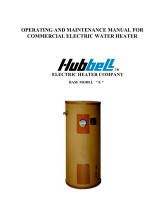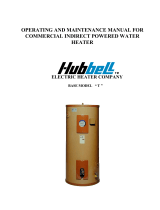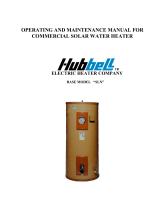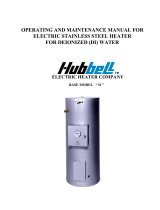Page is loading ...

OPERATING AND MAINTENANCE MANUAL FOR
STEAM FIRED WATER HEATER
ELECTRIC HEATER COMPANY
BASE MODEL “ ST and STH ”

2
HUBBELL ELECTRIC HEATER COMPANY
P.O. BOX 288
STRATFORD, CT 06615
PHONE: (203) 378-2659
FAX: (203) 378-3593
INTERNET: http://www.hubbellheaters.com/
-- IMPORTANT --
Always reference the full model number and serial number when calling the factory.
WARNING / CAUTION
1. Tank is to be completely filled with water and all air is to be vented before energizing.
2. Due to the rigors of transportation, all connections should be checked for tightness before heater
is placed in operation.
3. Safety relief valve must be installed in tapping provided.
4. KEEP AWAY FROM LIVE ELECTRICAL CIRCUITS.
Do not perform any maintenance, make any adjustments, or replace any components inside the
control panel with the high voltage power supply turned on. Under certain circumstances,
dangerous potentials may exist even when the power supply is off. To avoid casualties, always
turn the power supply safety switch to off, turn the charge or ground the circuit before
performing any maintenance or adjustment procedure.
5. Generalized instructions and procedures cannot anticipate all situations. For this reason, only
qualified installers should perform the installation. A qualified installer is a person who has
licensed training and a working knowledge of the applicable codes regulation, tools, equipment,
and methods necessary for safe installation of a steam fired water heater. If questions regarding
installation arise, check with your local plumbing and electrical inspectors for proper
procedures and codes. If you cannot obtain the required information, contact the company.

3
TABLE OF CONTENTS
SECTION TITLE PAGE #
I GENERAL DESCRIPTION AND CONSTRUCTION 9
II INSTALLATION AND OPERATION 13
III SCHEDULED MAINTENANCE AND SERVICING 18
IV ADJUSTMENT OF TEMPERATURE REGULATORS 25
V TROUBLESHOOTING 28
VI MISCELLANEOUS CHARTS AND FORMULAS 30

4

5

6
NOMENCLATURE FOR PARTS

7
NOMENCLATURE FOR ACCESSORY PARTS

8

9
SECTION I - GENERAL DESCRIPTION AND CONSTRUCTION
GENERAL DESCRIPTION
This book describes a packaged steam powered water heater that is a stationary, self-contained unit.
The complete assembly on a standard unit consists of the storage tank, immersion heating coil, steam
regulator, steam drip trap, condensate trap, steam strainer, condensate strainer, vacuum breaker, and
an ASME rated combination temperature and pressure safety relief valve. Optional equipment may
be supplied with your unit. Please consult the product drawing for details specific to your assembly.
The unit is factory assembled, insulated, jacketed, primed, painted, piped, tested, and ready for
service connections.
CONSTRUCTION
TANK
Standard Tank Construction:
The standard storage tank is constructed of all welded carbon steel, designed and built in accordance
with ASME Section VIII and stamped, certified, and registered with the National Board of Boiler and
Pressure Vessel Inspectors. It is internally lined with specially formulated Hydrastone cement to a 5/8-
inch minimum thickness for superior protection and tank longevity.
Optional Tank Linings:
1. Phenolic – An epoxy coating applied in two coats to a total thickness of 10-12 mils. Typically
used in process applications using low conductivity deionized (DI), distilled, or food grade
water.
2. Copper – A 3lb./sq. ft. copper sheet approximately 0.0646-inches thick covers all interior
surfaces. All copper sheet seams are factory tested to ensure long lasting protection of the steel
vessel.
3. Flame-Spray Copper – Molten copper is sprayed on the interior surfaces to a thickness of 5-6
mils. The copper bonds to the steel, and an additional overcoat of Phenolic lining is applied on
the copper to seal all pores.
4. Galvanizing – The steel pressure vessel is pickled and hot dipped in molten zinc to create a
barrier which internally and externally protects the steel vessel for cold and hot water storage.
Optional Non-Ferrous Tank Materials:
1. Copper-Silicon – A copper-silicon alloy offers tremendous tank longevity due to its ability to
withstand the cycling effects induced from changes in water temperature and pressure. This
material is suitable for storage of hot potable water in a variety of commercial and industrial
applications.
2. 90/10 Copper-Nickel – A 90% copper and 10% nickel alloy similar to copper-silicon, but with
added strength and corrosion resistance. Typically used in applications with corrosive
environments (salt water) or critical applications.

10
3. Stainless Steel – Stainless steel (type 304, 316, or 316L) is well suited for high purity
applications requiring a corrosion resistant tank with minimal leaching of impurities into the
water. Well suited for process, RO, and DI water systems in the pharmaceutical, food, and
electronic industries.
TANK CONNECTIONS
The heater is supplied with separate cold water and hot water connections. A connection is provided for
mounting a combination safety temperature and pressure relief valve. An overflow line should be
utilized from the relief valve outlet to a floor drain. See drawing for locations and sizes.
OUTER SHELL, INSULATION, AND SUPPORTS
The tank is encapsulated in 2-inches of high-density fiberglass insulation. The protective shell is
constructed of galvaneel and is coated with a durable silver hammertone finish. The entire vessel is
supported on heavy-duty integrally welded steel supports for sturdy floor mounting.
STEAM HEATING COIL
The water heater is supplied with a high quality factory installed 2-pass U-tube heating coil constructed
from 20-gauge ¾-inch O.D. single wall copper tubing designed for a maximum working pressure of
150 psi. The tubing is installed in a heavy-duty fabricated steel head with threaded NPT steam and
condensate connections. Each assembly is fastened to a corresponding tank flange using a gasket and
hex head steel bolts and nuts. Specialized heating coil construction may be included. These options
include: double wall tubing with a leak detection port, or special materials (stainless steel, 90/10
copper-nickel, other) for the tubes and/or head. See drawing for complete details.

11
STEAM OPERATING CONTROLS
The steam operating controls are factory selected, sized, piped, and tested to ensure reliable
operation. Steam controls can be shipped loose, upon request, for in the field installation by others.
All steam components are factory plumbed with schedule 40 black iron pipe and ready for steam and
condensate connections. A cast iron ‘Y’ strainer with 20 mesh screen protects the steam controls and
coil from dirt and debris in the steam supply.
Traps
Two traps should be utilized in the immediate steam piping system of the water heater. The first trap in
the system is a drip trap that is designed to collect condensate from the main steam line before entering
the steam regulator. Additionally, a main condensate trap should be located in the condensate line after
the steam coil. This trap ensures that the steam remains in the coil and releases its energy before exiting
the coil and traveling down the condensate line. There are various types of traps available. The
following may be included in your water heater package:
1. Drip Trap
a. Thermostatic (Standard)
b. Cast Iron Float and Thermostatic type
c. Cast Steel Float and Thermostatic type
2. Main Trap
a. Cast Iron Float and Thermostatic type (Standard)
b. Cast Steel Float and Thermostatic type
c. Bucket
Steam Control Valves
1. Pilot Operated (Standard) – A high quality cast iron pilot operated steam control valve
comes with the standard unit. It is the most widely used type of valve for water heating
applications. In this type of valve, a temperature pilot device utilizes steam to operate the
main valve. No external power source is required other than steam. This highly dependable
temperature control system is suitable for most commercial and industrial applications.
2. Self Operating – This valve design includes a bulb and capillary assembly charged with a
thermally responsive vapor. The expansion / contraction of the vapor acts upon the valve
bellows in order to control the flow of steam through the valve. No external power is required
for operation.
3. Pneumatically Operated – In this configuration the building air supply feeds a factory
installed temperature controller that operates the steam control valve. The temperature
controller sends a precise air signal to the steam control valve which adjusts the flow of
steam into the heating coil. The temperature controller is fully adjustable from 50° - 250 ° F
and requires 20 psi air at a maximum consumption of 0.5 SCFM.
4. Electronically Operated – This control valve is similar to a pneumatically operated system,
except in this case the temperature controller is a sophisticated digital display electronic
device which outputs a 4-20 ma signal to a compact motor mounted on the steam control
valve in order to proportionally control the flow of steam to the heating coil. The temperature
controller displays set point as well as actual water temperature and is available with an
RS485 communications port for remote control.

12
OPTIONS
The following optional features may be included in your water heater. Reference the drawing
specific to your heater for further details.
Single Solenoid Safety System
A single solenoid safety system closes the steam supply to the control valve should the temperature
in the tank reach the high limit set point. This option requires 120-volt, 5-amp electrical service.
Double Solenoid Safety System
A double solenoid safety system dumps over heated water in the storage tank to drain in addition to
closing the steam supply to the control valve. This option requires 120-volt, 5-amp electrical service.
Anticipator Control System
The anticipator control system forces incoming cold water over the control valve sensing bulb in
order to begin heating water immediately.
Skid Mounting
Optionally, the unit may be mounted on heavy duty all welded I-beams.
Circulating Pump Package
An intra-tank circulation pump package with On/Off switch to continuously circulate water within the
tank and thereby reduce stratification may be installed. An all bronze circulator pump.
Dial Temperature and Pressure Gauge
A combination temperature (70° - 250° F) and pressure (0 – 200 psi) gauge with 2½-inch dial may be
factory installed in the tank.

13
SECTION II – INSTALLATION AND OPERATION
WARNING / CAUTION
DO NOT TURN ON THE STEAM SUPPLY to this unit until heater is completely filled with water
and all air has been released. If the heater is NOT filled with water when the steam supply is turned
on, damage to the heating coil may result.
For protection against excessive pressures and temperatures, local codes require the installation of a
temperature-and-pressure (T&P) relief valve certified by a nationally recognized laboratory that
maintains periodic inspection of production of listed equipment of materials, as meeting the
requirements for Relief Valves and Automatic Gas Shutoff for Hot Water Supply Systems. ANSI
Z21.22-1971. THE CUSTOMER IS RESPONSIBLE TO PROTECT PROPERTY AND
PERSONNEL FROM HARM WHEN THE VALVE FUNCTIONS.
All water heaters have a risk of leakage at some unpredictable time. IT IS THE CUSTOMER'S
RESPONSIBILITY TO PROVIDE A CATCH PAN OR OTHER ADEQUATE MEANS, SO THAT
THE RESULTANT FLOW OF WATER WILL NOT DAMAGE PROPERTY.
If unit is painted or insulated on the job site, care should be taken not to paint or insulate over the
A.S.M.E. nameplate. This plate should be accessible and legible at all times to inspectors, and
information from this plate must be used when ordering parts from the factory.
The tank should be fully drained in the event the steam has been turned off and if there is danger of
freezing. If tank is drained and to be left empty for more than 8 hours, at least 2-inches of water should
be left in the bottom of cement lined tanks to prevent lining from drying and cracking.
WATER HEATER PLACEMENT
1. Adequate space should be provided for removal of heating element.
2. Unit should be level to permit proper drainage
PIPING INSTALLATION
NOTE:
The most effective means for preventing deterioration from accelerated corrosion due to
galvanic and stray current is the installation of dielectric fittings/unions. The installation of these
fittings is the responsibility of the installing contractor.
1. All integral components have been properly sized to meet design conditions. Piping to the
unit should be sized to meet the design conditions, as dictated by good engineering practices.
2. Refer to the enclosed drawing for location of piping connection.

14
3. Install the combination temperature and pressure safety relief valve in the tapping provided.
Note that this is required by law for safety considerations.
Outlet to floor drain
Install into provided tapping
Manual Release
Lever
Temperature Probe
4. Install a relief valve overflow pipe to a nearby floor drain. CAUTION: No valve of any type
should be installed between the relief valve and tank or in the drain line.
HOOK-UP OF AIR AND WATER OPERATED CONTROLS
1. Most air or water operated valves on Hubbell water heaters are controlled by Powers
Accritem. Occasionally, a Robertshaw Fultrol is furnished which operates identically to the
Powers control except supply and output connections are reversed in location. Controls are
normally mounted on the back side of the tank shell.

15
Typical Piping Diagram
ELECTRICAL INSTALLATION
1.
If the unit is furnished with a pilot or self contained control valve, no external source
of power is required for the valve. (See enclosed operation and maintenance manual
for specific valves).
2. If the unit is furnished with an air or electric control valve, see enclosed drawings for
required connections. (See enclosed operation and maintenance manuals for specific
valves).
3. Torque screws per torque chart included in Section VI.
4. All other electrical connections are made at the factory; therefore, no other electrical
connections are necessary.

16
FILLING THE HEATER
1. Begin with all steam, condensate, and water valves closed.
2. Open the isolation valves on the integral circulator line ,if supplied.
3. Open cold water valve, fill unit with cold water. Lift lever on relief valve to relieve trapped
air. Release relief valve lever when all traces of air have been vented from the unit. Leave
cold water valve open.
STARTUP
1. Turn pump switch to the “ON” position, if supplied. (Do not operate pump without unit being
filled with water and isolation valves being opened, as damage to the pump could result).
2. Set control valve thermostat to approximately 30° F below desired temperature, observe unit,
if unit operates properly gradually raise set point to desired set point.
3. If unit has a safety system, set hi-limit thermostat to desired temperature. (This thermostat
must be set at a higher temperature than the operating thermostat or the unit will never reach
the desired temperature). Refer to the enclosed piping and wiring drawings.
4. Gradually open valve to allow heating medium to enter the heating element. (Boiler water
lines should be vented to eliminate trapped air). Monitor the tank temperature until the
desired temperature is reached. If the temperature regulator shuts off before the desired
temperature is reached, or if over-shoot occurs, adjustment of the temperature regulator will
be required. (Refer to enclosed O&M manuals for your specific control valve).
5. After control valve adjustments have been made and the desired temperature has been
reached, open the valve on the hot water outlet and the building recirculation line.
6. Tightening of some gasketed joints may be required after unit has been heated.
7. Never break any joint, gasketed or screwed on unit until the pressure in the unit has been
reduced to zero and the unit drained.
8. Observe operation of unit for 30-40 minutes after initial start up.

17
SHUTDOWN
1. Close valve to heating medium and air supply valve, if air operated controls are furnished
2. Disconnect all electrical power to unit.
3. Close hot water outlet valve.
4. Close building recirculation inlet valve, and shut down building circulation pump.
5. Close cold water inlet valve.
6. Turn off pump, if supplied.
7. Drain unit by lifting lever on relief valve to vent tank, then slowly open drain valve.

18
SECTION III - SCHEDULED MAINTENANCE AND SERVICING
WARNING / CAUTION
Before performing any maintenance procedure, make certain steam supply and electrical power
supply is OFF and cannot accidentally be turned on.
QUARTERLY INSPECTION
1. Monitor thermostat
a. Let water heater completely heat to a designated thermostat setting.
b. After thermostat satisfies (that is, when the thermostat actually clicks off), draw water from
heater.
c. Compare water temperature of drawn water to the temperature setting of the thermostat
when it satisfies. Normal variation between the two points is approximately + 5°F.
d. If these two readings do not coincide within acceptable tolerances and verification has
been made of the accuracy of the temperature-reading gauge, replace the thermostat.
2. Lift test lever on relief valve and let water run through valve for a period of approximately 10
seconds. This will help flush away any sediment that might build up in water passageways.
ANNUAL INSPECTION
1. Units subject to fouling or scaling should be cleaned periodically. A marked increase in
pressure drop and/or reduction in performance usually indicates cleaning is necessary.
2. To clean inside of tubes, remove all heads and covers. (Caution: Do not loosen heads until
you are sure all pressure is off the equipment, and the unit is drained).
3. In cleaning a tube bundle, tubes should not be hammered on. If it is necessary to use scrapers,
care should be taken to insure that the tubes are not damaged.
4. Before it is necessary to apply mechanical means for cleaning, try to clean the unit using the
following methods.
a. Circulate hot fresh water at a reasonable velocity.
b. Try spraying with water hose.
c. Consult with manufacturers of cleaning compounds and chemicals. They will check the
nature of the deposit, recommend the right cleaning compound, and in many cases
provide equipment and personnel for a complete cleaning job.
5. Do not clean tubes by blowing steam through individual tubes.
6. To tighten a loose tube joint, use a suitable roller type tube expander. Do not roll tubes that
are not leaking. If double wall tubes are supplied return to the factory for repairs.
7. If the unit is dismantled for any reason, it should be reassembled using new gaskets.
8. Do not tighten bolts until gaskets are properly seated.
9. Exterior of unit should be cleaned and if necessary repainted.
10. When tightening bolts in the element head, tighten the bolts in a criss-cross pattern. This will
evenly distribute pressure around the flange, and help prevent warping. See diagram below.

19
11. Convection packages may be equipped with an integral circulator. This circulator should be
serviced per the enclosed pump O&M manual.
12. The unit as well as all strainers should be blown down regularly to remove any trash, and
sediment that may have accumulated.
13. If unit is supplied with anode rod, it shall be inspected for excessive wear.
14. Packing on valves and regulators should be checked for leaks and repaired or replaced as
necessary.
15. To seal the manhole gasket, first install the cover, crab, new gasket, bolt and nut. Turn the
nut until it is snug against the crab, then turn 1 ½ revolutions. Fill the tank with water and
allow pressure to build up, letting the water pressure seal the gasket. (Some leakage may

20
occur at this point, but as the gasket seats, leaking will gradually stop). After leaking has
stopped, turn the nut approximately 1 revolution. At this point there may be some miner
seepage, wait a few minutes to see if this seepage stops. If seepage continues drain the tank,
inspect the manhole ring, and cover for any damage, (repair or replace as required) Repeat
the above procedure using a new gasket.
Never try to seal the cover solely by turning the nut down tight this may cut or crush
the gasket and make sealing impossible.
16. Drain and flush tank as follows. Perform annually or more often , if required. NOTE: Cement
lining is a durable lining that will provide many years of service protecting your steel
pressure vessel from corrosion. The process of cement lining includes an inspection to ensure
that the lining is applied to the correct thickness, covers all appropriate surfaces, and is free
from defects or cracks greater than 3 mm (1/8”) in width. Any deficiencies are repaired at the
factory prior to shipment. However, it is characteristic to find hairline cracks in the cement
lining prior to initial installation. After the vessel is first filled, the water will work its way
into these cracks and begin the corrosion process. At the same time the cement lining
undergoes a “wet curing” process whereby the cement absorbs water and expands. The water
that is absorbed into the lining becomes trapped between the cement lining and the steel tank
and once the cement is fully absorbed with water, the water in contact with the steel tank
becomes deoxygenated which serves to protect the steel vessel. In addition, the cement
leaches minerals and various impurities from the water which fills and “heals” the cracks.
This “healing” together with the “wet curing” and expansion of the cement prevents any
ongoing corrosion. In the unlikely event a crack greater than 3 mm (1/8”) develops, the
cement lining can be easily repaired in the field. For repair procedures please contact Hubbell
a. Shut down unit as described in Section II.
b. Close valve on hot water outlet piping.
c. Open valve on drain piping.
d. Cold water inlet line pressure will be strong enough to flush sediment from the bottom of
the tank out through the drain. Let water run for 3-4 minutes.
e. Clean strainer filter, see below.
f. Close drain valve.
g. Open hot water valve.
h. Re-start unit as described in Section II
.
17. Clean strainer filter. Perform annually or more often , if required.
a. Remove blowoff bushing (E) or cap (F), as required.
b. Remove gasket (B), if required.
c. Remove, clean, and re-install screen (A).
d. Replace gasket (B).
e. Re-install blowoff bushing (E) or cap (F), as required.
/






